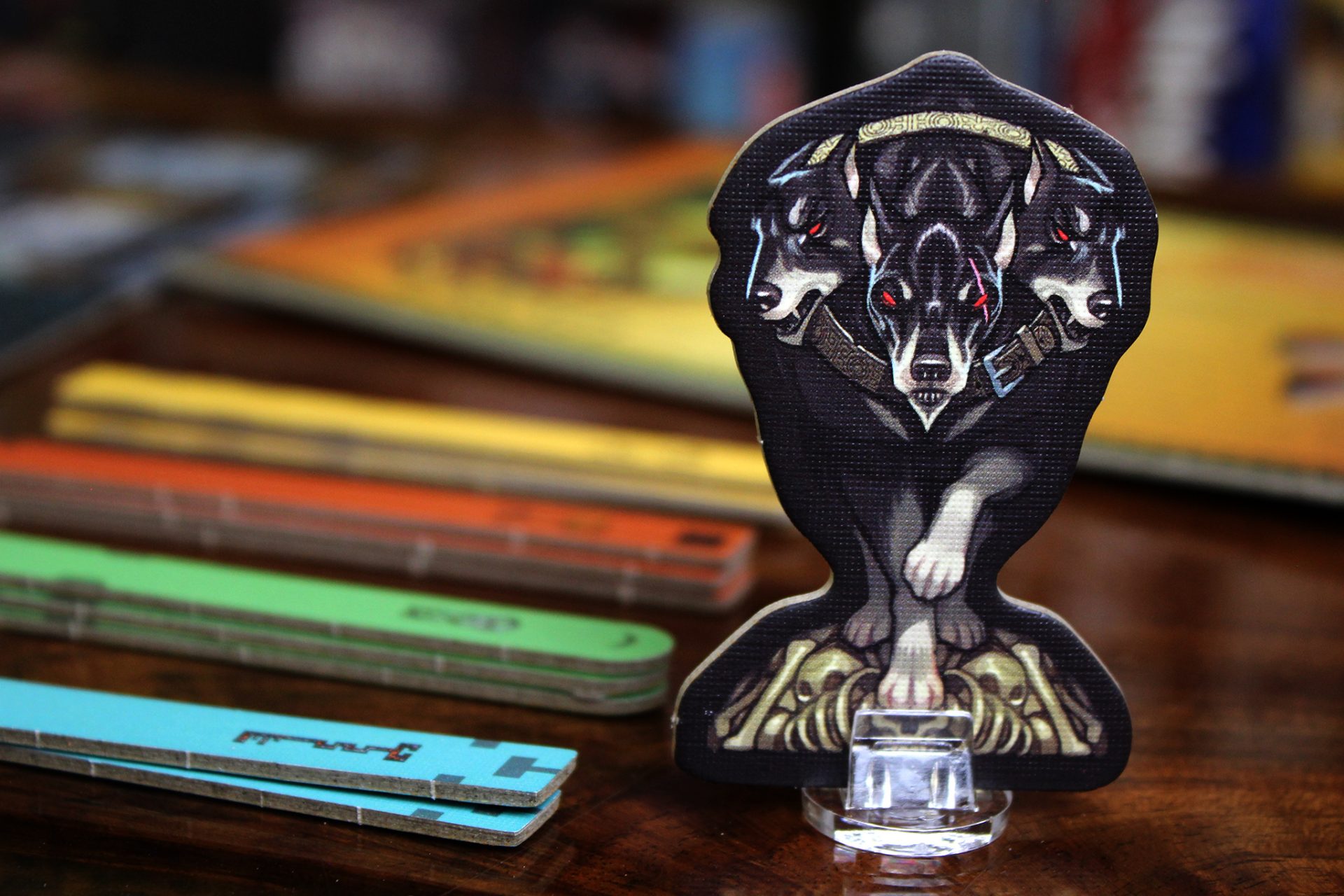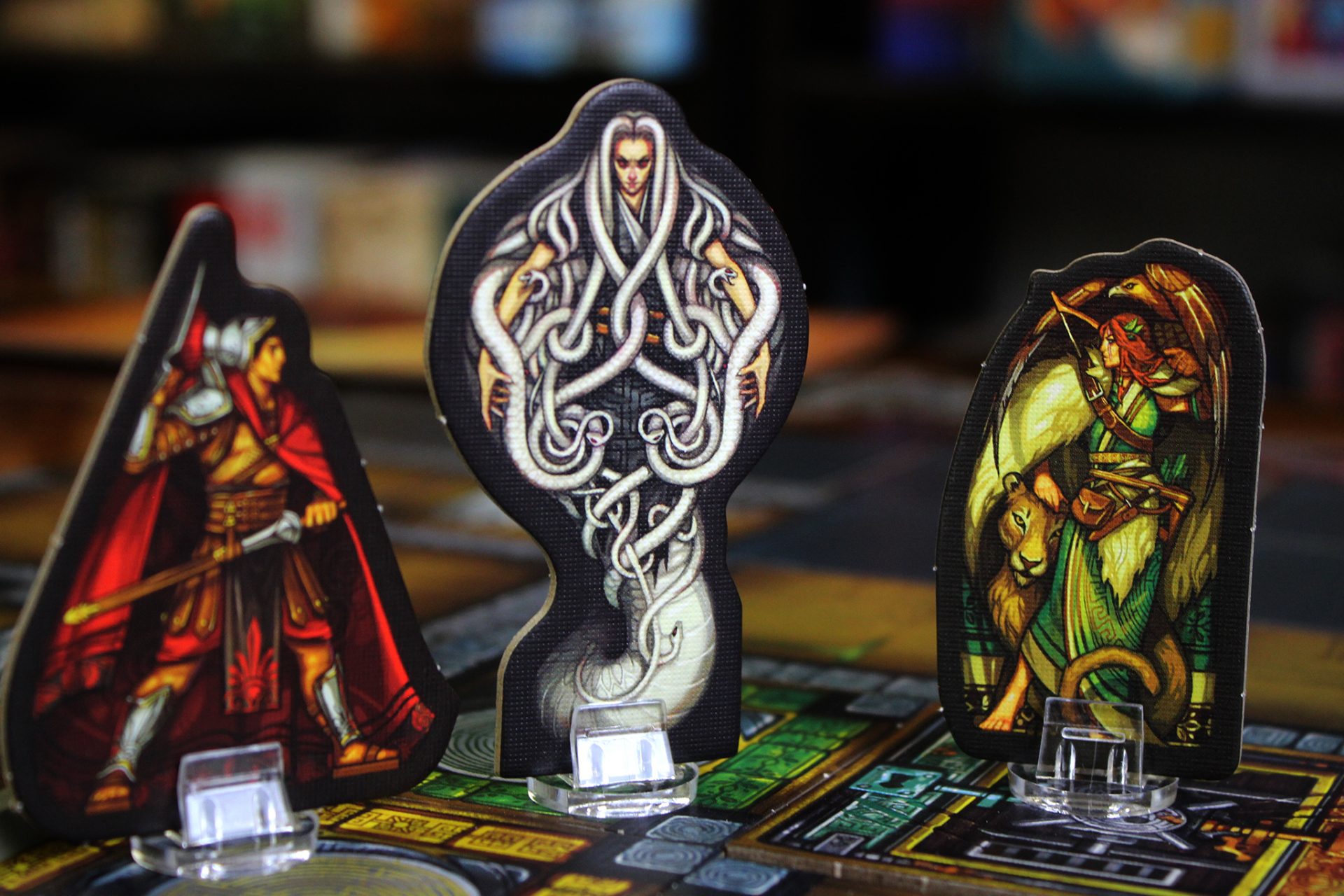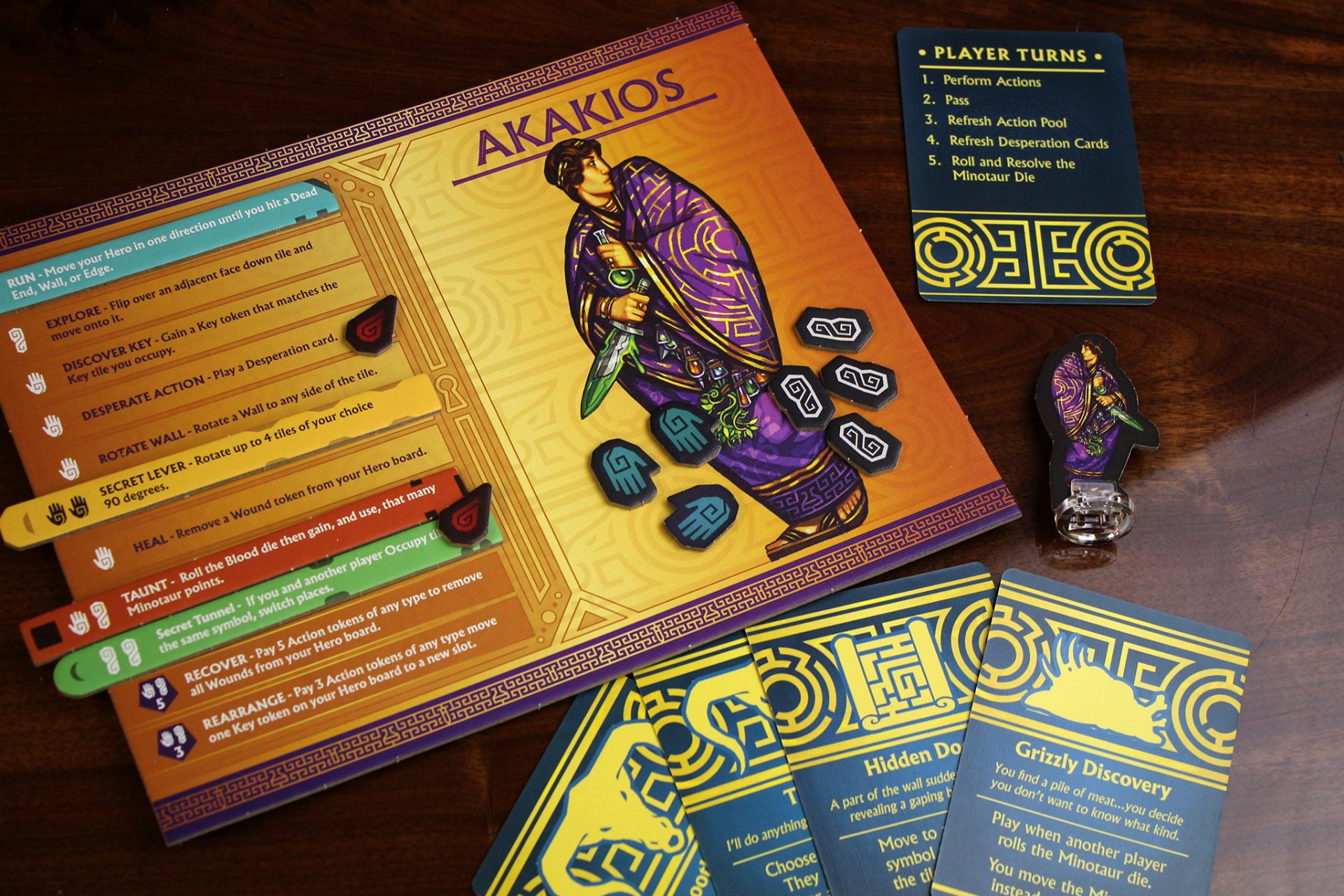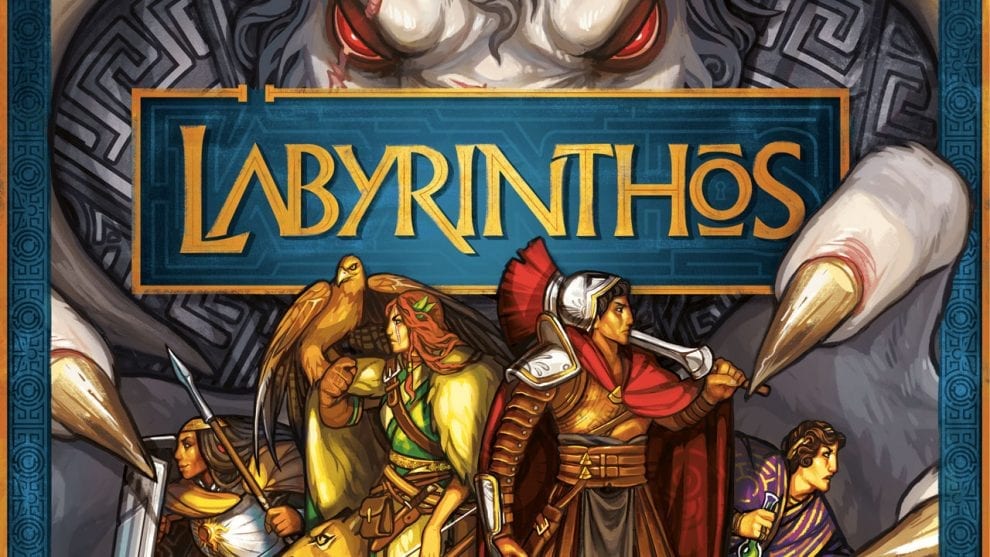Disclosure: Meeple Mountain received a free copy of this product in exchange for an honest, unbiased review. This review is not intended to be an endorsement.
Labyrinthos. Not Labyrinth; not Mythos. Maybe even Labyrinth, Though. Instead, we got Labyrinthos.
It sounds like a bad Western, right?
Labyrinthos, a board game designed by Lindsey Rose and published by Dog Might Games, does wear a smirk throughout its delivery. From the tongue-in-cheek rulebook to the artwork by Alyssa Menold, Labyrinthos is a light and semi-interactive good time. While it never reaches the pinnacle of greatness for its category, it features interesting decisions and fun character abilities, which change from game to game.
I just wish it had a different title.

Minotaur, Cerberus, Medusa—Oh My!
The goal of Labyrinthos is a straight loot run: find the four key tiles to escape the maze. Also, just a heads-up—there’s a monster chasing the players for the entire game, wreaking havoc on the proceedings.
The board is a 7×7 grid of tiles, which can be placed on your garden-variety dining room table OR a very handsome (and completely unnecessary) neoprene mat, which helps keep your 49 tiles organized a little better than your table might. You don’t necessarily need the mat, but the mat does look really nice on the table!
Nine of those 49 tiles are the central 3×3 tile grid that includes the exit door, plus a few starter tiles with spaces for each of the players to place their character standee. The remaining 40 tiles are left facedown to begin the game—leaving a very large board to explore, especially in a game with a lower player count. The hidden tiles are a mix of traps, secret passages, hiding spots, and key tiles, which you’ll ultimately need to find in order to get out of the maze.
Players take turns using 7 action tokens shaped as either hands or feet to take actions listed on their player boards. These include actions such as moving, discovering new tiles, healing, and taking a key from a discovered key tile. You can also rotate tiles to manipulate the maze, move temporary walls around, and use the unique special ability found on each character’s player board.
But the best part of the actions in Labyrinthos is upgrading them by discovering keys. When you discover a key tile and take the additional action to pick up a key, you gain an ability that replaces (and usually upgrades) another action you had before. Often these upgraded actions cost more action tokens, but make your overall skills sizably more efficient. In rare cases you’ll add a key tile to your board that costs no actions at all!
And you’ll need these upgraded actions, because after each player completes their main actions they get to control the monster by rolling an action die and moving it in a direction of their choosing. Often, especially early in my games, we used these moves to go after other players and wound them with the monster’s attacks. In Labyrinthos, it’s impossible to be killed—these are mythical Greek heroes, after all—but wounds are taken to your various actions, mostly at the player’s choosing. For example, a beast might hit you for three damage points on a turn, but you can choose to wound your Explore ability, or your Discovery Key ability, etc. This hampers your ability to string efficient turns together, but not for long if you can heal up and keep moving!
Later in the game, while plotting your escape and trying to grab a third, then the fourth, key, you may use the monster’s move to block other players or to just move the monster in a direction that opens a path for you to run out of the maze. But you are going to get attacked a bunch when you get that fourth key; once the other players recognize you are about to win, they’ll throw everything they have at you, because you can never lose a key once you’ve gained it.
Throwing a curveball into all of this is The Desperation card deck. All of the cards break the rules of Labyrinthos somehow, and as a catch-up mechanic, the less keys you have, the more Desperation cards you can hold. When you have all four keys, you can’t hold ANY Desperation cards, giving other players every chance possible to mess with your plans. Early on, these cards are a hoot; they let you magically move players all over the map, swap key action powers with other players, and even warp the game’s monster to any discovered tile you would like. They all seem completely different and are always a great change-up to what was happening on the board.
Labyrinthos lets you choose the monster that will chase players around the map. The base game monster is The Minotaur but you can spice things up with the three-headed pup Cerberus (maybe “pup” is not a perfect description), who chases after any hero to which it has line of sight, or Medusa, who forces players to take wound tokens from top to bottom on the player board. For Medusa, this means your first wound always covers the Move action, because when you look into Medusa’s eyes you turn to stone, remember?

Titans, Clashing
At 4 players, and even 3 players, the chaos engine that Labyrinthos creates is fun, quick, very interactive, and just mean enough to not really be mean, but more of an inconvenience. As such, it plays well as a friendly game with newer gamers or those who are very familiar with each other. In our games, players branch out all over the board to start, trying desperately to find those key tiles and quickly upgrade the starting player powers.
The tile placements provide great variability. This is both good and bad. In my most recent game of Labyrinthos, 3 keys were revealed in a small section of 4 consecutive tiles. For 2 of the players, that was great news; for a third, exploring the opposite corner of the map, not only were there no keys on that side of the map, there were no secret passage tiles that allowed for this person to simply warp to the other side of the board. (Sometimes, you might even have a Desperation card to dig you out of a tough situation like this, but not for this particular player!)
Situations like this happen frequently with Labyrinthos, and that certainly has a negative impact on the game. I wouldn’t even call this swingy; the tile placement is intentionally random, so sometimes, it’s just bad luck to be on the other side of the map from the key tile locations. For a short game — none of my games have taken longer than an hour, regardless of player count — I don’t have an issue with this. With a glass of wine and some friends, Labyrinthos never overstays its welcome and delivers an interesting experience each time it hits the table.
A note about playing Labyrinthos with only 2 players: don’t. In a 2-player game, the game board features too many tiles. A 6×6 tile layout or maybe even 5×5 with only 3 keys might work better, which would be simple to house rule. But playing the game as designed, a 2-player game where the key tiles are tucked into the outside corners of the map makes them difficult to discover. For a game of this type to take longer than 30 minutes with 2 players is less than ideal because there just aren’t enough interesting things to do over that long of a period.
The worst part about the 2-player experience is the monster movement phase. In essence, one player moves the monster a few spaces towards the opposing player character, then on the next monster move turn, the other player just hits “undo” and moves the monster a few steps back towards the other player. My wife is always the victim when I play games with 2 players, and I could tell this element wasn’t working for her!

Should You Enter the Maze?
I’ve had fun playing Labyrinthos; the gameplay is fluid and the ways the actions, Desperation cards and key powers interlock are fun to discover each time I have played. At 4 players, this game really shines as a 45-minute dungeon crawl where players can lob obstacles at each other while racing to collect the 4 keys needed to escape.
The artwork is maybe my favorite part of the production; tiles are fine, but the player boards and the symbols for hands and feet just really resonated with me. While the neoprene mat is not needed to enjoy the game, it enhances the experience and gives the presentation a very clean look to it.
As mentioned previously, the biggest negative is the gameplay experience for 2 players, but gamers with a larger group should be able to avoid that issue. Also, a random tile draw that leaves one player out in the cold not discovering new tiles in one section of the board will leave that person rueing the day they signed on to play this game, but it’s hard to predict when that might happen.
Labyrinthos is good, never great, and essentially requires a full 4-player count to see it shine. If you’ve got the right explorers ready to go, grab a copy!











Good review but some more pictures of the game play, components etc would be very helpful